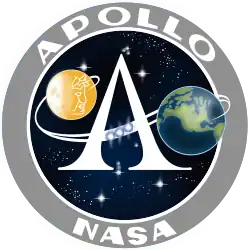

The Apollo 11 lunar sample display is a commemorative podium style plaque display consisting of four dust particle specimens (dubbed "Moon rocks"), the recipient's flag and two small metal plates attached with descriptive messages. The Apollo 11 plaques were given as gifts in 1970 by President Richard Nixon to 135 countries, the 50 states of the United States and its territories, and the United Nations.
History and description
At the request of Nixon, NASA had about 250 presentation plaques made following Apollo 11 in 1969. Each included about four rice-sized particles of Moon dust from the mission totaling about 50 mg.[1][2] The Apollo 11 lunar sample display has an acrylic plastic button containing the Moon dust mounted with the recipient's country or state flag that had been to the Moon and back. All 135 countries received the display, as did the 50 states of the United States and the U.S. provinces and the United Nations.[1]
The plaques were given as gifts by Nixon in 1970.[1] With the exception of Venezuela, whose actual flag was not flown to the Moon on Apollo 11, the wording on the plaque (with the appropriate name filled in) was:[1]
"Presented to the people of _____ by Richard Nixon, President of the United States of America.
"This flag of your state was carried to the Moon and back by Apollo 11 and this fragment of the Moon's surface was brought to Earth by the crew of that first manned lunar landing."
Fate
The New York Times reported in 2012 that gifts of moon rocks were not well tracked or managed by NASA.[3] Within the US, public gifts require legislation to be transferred, but other nations set their own laws.[1] Some samples of lunar dust soil from the Apollo 11 and lunar basalt 70017 from the later Apollo 17 missions have been reported missing.[1][4] Since 2005 entities and people have made concerted efforts to find the displays.[5][6][7] Joseph Gutheinz, a former NASA Office of Inspector General special agent and a professor[8] who teaches an online course at the University of Phoenix,[9] had his students try to locate the displays. Robert Pearlman of collectSPACE has also tracked the displays.[1][4]
See also
References
- 1 2 3 4 5 6 7 Pearlman, Robert. "Where today are the Apollo 11 goodwill lunar sample displays?". CollectSPACE. Archived from the original on November 8, 2020. Retrieved November 2, 2012.
- ↑ "Tales of lunar rocks through the years". The San Diego Union-Tribune. Associated Press. 2012-05-23. Archived from the original on 2023-02-06. Retrieved 2023-02-06.
- ↑ Fernandez, Manny (January 21, 2012). "NASA Searches for Loot That Traveled From Space to Another Void". The New York Times. Houston, Texas. Retrieved November 3, 2012.
- 1 2 Pearlman, Robert. "Where today are the Apollo 17 goodwill lunar sample displays". CollectSPACE. Retrieved 2023-02-06.
- ↑ "Houston lawyer on quest for missing moon rocks". Buffalo, Texas. Associated Press. May 14, 2012. Retrieved November 3, 2012 – via Fox News.
- ↑ "Customs agents seize 4 billion year old moon rock". cnn.com. CNN. December 7, 1998. Archived from the original on September 17, 2000. Retrieved November 3, 2012.
- ↑ Hennessy-Fiske, Molly (February 7, 2012). "Finding lost moon rocks is his mission". Los Angeles Times. Retrieved November 3, 2012.
- ↑ "One man's quest to find missing moon rocks". Detroit Free Press. Buffalo, Texas. 2012-05-14. Retrieved November 3, 2012.
- ↑ Silvey, Janese (July 8, 2010). "Moon rock discovery a false alarm: Apollo 17 keepsake still missing after all". Columbia Daily Tribune. Archived from the original on March 21, 2012. Retrieved November 4, 2012.

